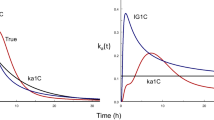Abstract
Throughout the literature, enzyme constants have been derived by utilizing in vivodata and indirectly assuming that these data were described by the one-compartment open model. However, many drugs are probably best described by a two-compartment open model with Michaelis-Menten elimination kinetics. Simulated data, which obey the two-compartment open model with Michaelis-Menten elimination, and which illustrate some of the interesting properties of such models, are presented. Treatment of two-compartment data by one-compartment analysis is shown to result in a serious distortion of enzyme parameters (V m ,K m ).For data which obey the two-compartment open model, estimation of the Michaelis-Menten constant (K m )and the maximum velocity (V m )by one-compartment analysis cannot be theoretically justified and therefore should be avoided.
Similar content being viewed by others
References
K. B. Bischoff and R. L. Dedrick. Thiopental pharmacokinetics.J. Pharm. Sci. 57: 1346–1351 (1968).
N. Gerber and J. G. Wagner. Explanation of dose-dependent decline of diphenylhydantoin plasma levels by fitting to the integrated form of the Michaelis-Menten equation.Res. Commun. Chem. Pathol. Pharmacol. 3: 455–466 (1968).
J. G. Wagner and J. A. Patel. Variations in absorption and elimination rate of ethyl alcohol in a single subject.Res. Commun. Chem. Pathol. Pharmacol. 4: 61–76 (1972).
G. Levy, T. Tsuchiya, and L. P. Amsel. Salicylate kinetics in man.Clin. Pharmacol. Therap. 13: 258–268 (1972).
J. P. Von Wartburg, J. L. Bethune, and B. L. Vallee. Liver alcohol dehydrogenase: Kinetic and physicochemical properties.Biochemistry 3: 1775–1782 (1964).
A. H. Blair and B. L. Vallee. Some catalytic properties of human liver alcohol dehydrogenase.Biochemistry 5: 2026–2034 (1966).
R. L. Dedrick and D. D. Forrester. Blood flow limitations in interpreting Michaelis constants for ethanol oxidationin vivo.Biochem. Pharmacol. 22: 1133–1140 (1973).
H. N. Christensen and G. A. Palmer.Enzyme Kinetics, Saunders, Philadelphia, 1967, pp. 101–103.
Author information
Authors and Affiliations
Additional information
Supported in part by Public Health Service Grant 5-P11-GM15559.
Rights and permissions
About this article
Cite this article
Sedman, A.J., Wagner, J.G. Importance of the use of the appropriate pharmacokinetic model to analyzein vivo enzyme constants. Journal of Pharmacokinetics and Biopharmaceutics 2, 161–173 (1974). https://doi.org/10.1007/BF01061506
Received:
Revised:
Published:
Issue Date:
DOI: https://doi.org/10.1007/BF01061506




